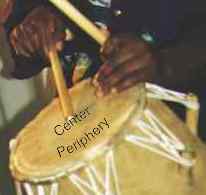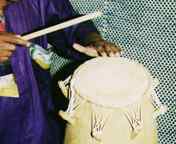Atsimevu in a playing position
Atsimevu has a carved cylindrical body of about four and one half feet tall with an expansion in the middle section of about fifteen inches in diameter and a drum head of about nine inches in diameter. The drum head or membrane is usually made out of a skin of a deer or antelope. The cylindrical body has an opening of about eight inches in diameter at the bottom to let the vibrations out.
The name Atsimevu was derived from the description of the manner in which the drum is tilted in a convenient playing position by the help of a functional stand called vudetsi.
Atsimevu in a playing position
Tonality And Performance Techniques
The initial vibration of Atsimevu is released by striking the membrane with a full bare hand technique, a stick technique, a technique employing the fingers and their combinations. Striking different positions of the membrane and manipulating the membrane by damping it to resonate partially in varied manners produce a series of pitches which form the basic vocabulary of Atsimevu.
While many things affect the pitches produced by Atsimevu - the quality of the carved cylindrical body, the thickness, diameter and tension of the membrane etc. - the aspect that has the most significance in the area of performance is the quality of the techniques that control the release of the various frequencies of vibration. These techniques are the primary concern of the performer and we shall discuss them in the context of the pitches they produce.
The most important attribute of a good drumming technique is, perhaps, a firm relaxation of the entire body as the hands go into motion, supported in position from the elbows and not the shoulders. The elbow is only a support mechanism for the hands held in a very relaxed but firm posture. The actual swing of the hand is done from the wrist and not from the elbows.
In a performance position, the drummer stands parallel beside Atsimevu, which is tilted by the help of vudetsi, bringing the height of the drum head below the chest for a good leverage and aiming position.
Two positions of the drum head are the most commonly used for striking: the center and the peripheral zone. Stick and full hand techniques are used at the center while the technique employing the fingers is used at the periphery.

Layout of the drumhead
Fundamental Pitch: "Ga"
The fundamental vibration of the air column within the drum is released by bouncing the bare hand off the center of the membrane. This produces the lowest pitch of the drum. This pitch is commonly referred to in vocal syllable as "Ga".
Fundamental Pitch "Ga"
Full Bare Hand Technique
Pitch: "Gi"
A stroke with the full fingers of the weak hand which rebounds after striking the drum head periphery produces a middle range pitch corresponding to the fundamental vibration mode of the membrane. It is identified in vocal syllable as "Gi".
Discovering the proper angle of the drum head periphery is very important for the clarity of the pitches produced by the technique employing the full fingers. This angle is commonly discovered by aligning the knuckles around the rim of the drum head, using the thumb as a guide, while the rest of the flexing fingers stretch towards the center of the drum head.

Pitch "Gi"
Full Fingers Technique
Pitch "Ki"
An alternate technique of the weak hand fingers releases a partial vibration of the membrane by pressing the fingers firmly on the drum head to prevent them from bouncing after the stroke is delivered. This technique produces a pitch commonly referred to in the vocal syllable as "Ki". In comparison with the pitch "Gi", the pitch "Ki" is higher.
Pitch "Ki"
Pressed Full Fingers Technique
![]() Atsimevu's Tonality And PerformanceTechniques Continue ...
Atsimevu's Tonality And PerformanceTechniques Continue ...
© Copyright 1995 C. K. Ladzekpo
All Rights Reserved
WebMastering
by
and